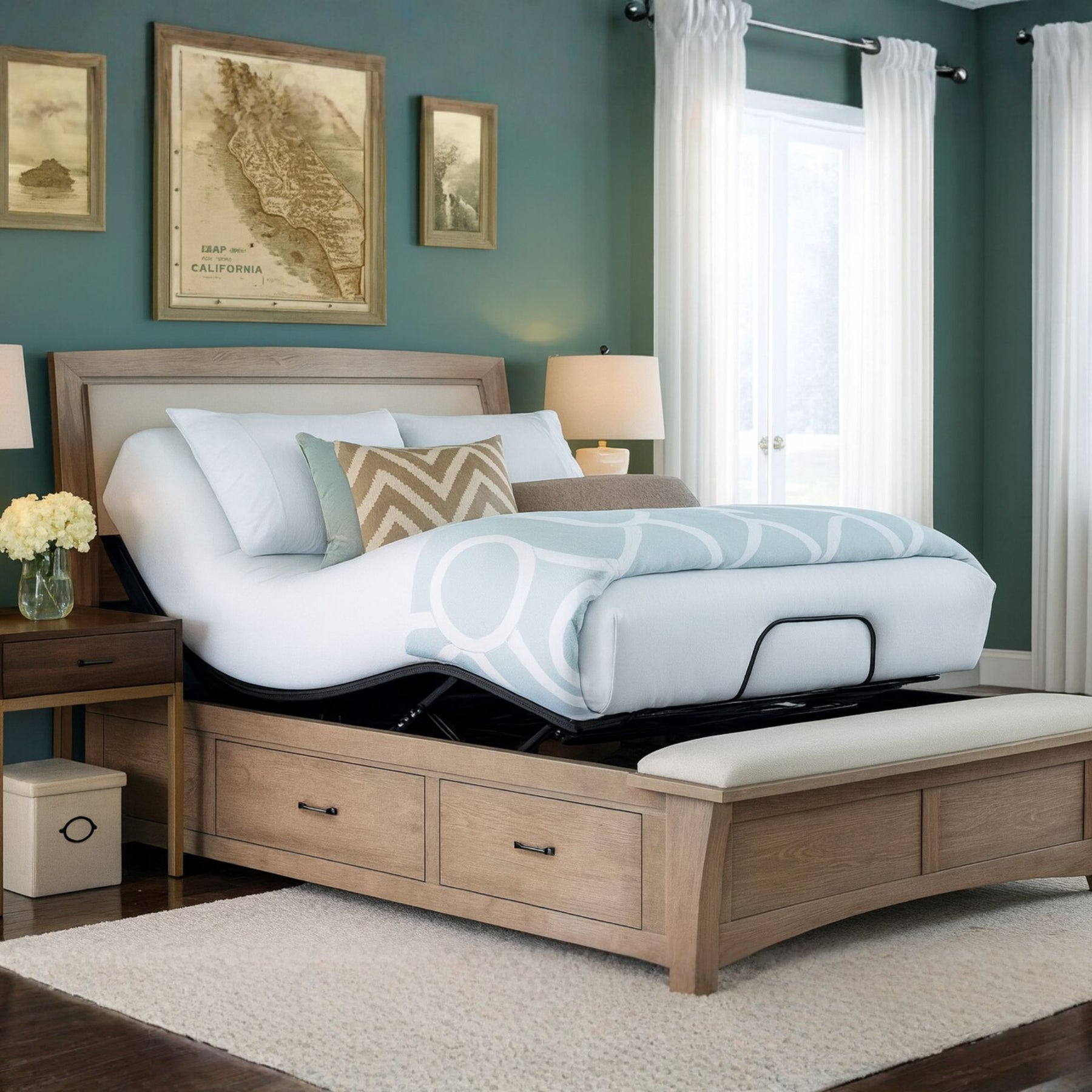Every bed has three fundamental parts: the bed frame, the mattress, and the support system. The structure that supports the mattress stops it from falling through the frame.
A bunkie board is thin and light mattress support intended for a bunk bed, the same as how a box spring supports a regular bed. It can perform the same function as box springs, but bunkie boards can replace them without taking up as much space. So most people choose a bunkie board vs. a box spring to save space.
There are typically three different kinds of support structures:
- box spring mattresses
- bed slats
- bunkie boards
This guide will offer the pros and cons of bunkie boards over a box spring. If you would like to learn more about the iSense split firmness mattress, that can be found here.
But first, let’s learn more about bunk bed boards, commonly known as bunkie boards.
Types of Bunkie Boards
Manufacturers can make bunk bed boards from particle board, plywood, or solid wood. Each material has advantages and disadvantages.
Plywood
Although plywood bunkers are strong and lightweight, they can be more expensive than particle board (unless you decide to use plywood to make your bunkie board). Plywood is made by bonding together several thin layers of wood.
Particle Board
Wood chips, which are glued together, form particle boards. Particle board bunkies make the least expensive alternative, but you must take caution as such a bunkie board may pose certain health risks.
The particle board will eventually break down and release potentially hazardous formaldehyde gases. Therefore, when choosing particle board, be aware of the type of formaldehyde in its manufacturing to lower health concerns.
We use phenol-formaldehyde (PF) or urea-formaldehyde (UF) to make particle boards. But since phenol-formaldehyde (PF) does not release fumes, it is safer to use than urea-formaldehyde, which is more poisonous.
Solid Wood
While solid wood bunkies are strong, they can be heavy and expensive. On the other hand, such bunkie boards are naturally robust and durable. While most people consider them costly, the extra expense is worth it since the bed frame lasts longer.
Benefits of Bunkie Boards
Bunkie boards have several benefits. First, their affordability is a significant plus. They are often much less expensive than any other foundation or box spring. Boards maintain their sleek low profile by streamlining and minimizing the bed.
Bunkie boards are helpful to foam mattresses, such as latex foam and memory foam mattresses, as slats frequently aren't strong enough to support them. It prevents the foam mattress from falling through or the support slats from breaking in a platform bed, with only slats as the sleeping surface. If you have a slatted bed frame, it's essential to use a bunkie board with a memory foam or hybrid mattress.
Slats, plywood, low-profile box springs, standard box springs, and split bunkie boards are common alternatives for bunkie boards. One of these bunkie board options may be a better option for you than a traditional bunkie bed, depending on your kind of bed and mattress, but all of them can support bunk bed mattresses.
Bunkie Boards vs. Box Spring
A bunkie board and a box spring have some similarities. For example, both offer support to your mattress to make it more comfortable. However, the two have many distinctions, starting with how they look.
A bunkie board comprises a sheet of material, usually 2 inches high. However, a box spring is a fabric-covered wood framework that occasionally features coils with a height of 9 inches.
Bunkie boards weigh roughly 30 pounds, depending on their material and size. However, a box spring frequently weighs almost 100 pounds. Hence, storing bunkie boards is much simpler, thanks to their portability.
A box spring is standard and required when you have traditional innerspring mattresses. However, new innerspring mattresses don't usually need one. Support slats or a sturdy basis, like platform beds or bunkie boards, are both suitable bases for innerspring mattresses.
Bunkie Board
- Easy to move and lightweight
- Typically 2 inches tall
- Made from a solid sheet of material such as particle board or wood
- Affordable
Box Spring
- Made from fabric, coils, and wood
- Generally 9 inches tall
- More expensive
- Much heavier
- More expensive
- It may become squeaky over the years
- The main difference that bunkie beds have over box springs is durability
How to Know if you Need Bunkie Boards
Are bunkie boards the perfect choice for you? Let's find out.
Slatted Foundations
Most modern bed frames, either wooden or upholstered, have slatted foundations. Choose a bunkie board of one- or two-inch inches, according to your desired bed height.
Adjustable Foundation
You will only need a bunkie board if your bed is adjustable firmness. However, the frame won't flex appropriately if there is anything between the mattress and the frame.
Solid Foundations
A bunkie board will not be helpful if you intend to put your mattress on a bed frame with a sturdy foundation or no slats. However, Bunkie boards are a terrific method to raise your mattress without weakening its construction and when you want your bed to be higher.
Are Bunkie Boards Available in Different Sizes?
The sizes of bunkie beds range from regular twin to California king. They are often accessible to most people due to their extensive selection.
You can also get split bunkie boards for the split queen or king beds. Even though they are merely two twin bunk beds positioned next to one another, they may individually provide support for split mattresses.
You can also ask a salesperson about the manufacturer's recommendations. If you are looking for a bunkie board for your new mattress and are still determining the exact brand, size, or depth, ask for the best bunkie board for your case. Frequently, specific mattresses come with bunkie boards that are made especially for the specific mattress's materials and construction.
How to Buy the Best Bunkie Boards
You can choose from a wide assortment of bunkie boards when purchasing them online. Additionally, bunkie boards are available in your local stores that sell mattresses and bedroom furnishings. You may usually get assistance from furniture stores in finding the right bunkie board for your bed frame. Finding the appropriate size bunkie board, whether you're shopping online or at a mattress store, is simple when using normal US bed measurements. Bunkie boards can cost anything from $50 to $150.
The price will add up as the bed gets bigger. There will probably be a price difference between a king and a double bunkie board. Stains and finishes, which are decorative characteristics, can also significantly affect the price.
Final Thoughts
There are several reasons for choosing bunkie boards but consider purchasing a bunkie board if you're seeking a solution to get a better night's sleep. Although box springs have long been the norm as a mattress foundation, bunkie boards offer a more streamlined, low-profile appearance. Additionally, they provide the proper support to your mattress.














